|
First Qualifying
Wednesday
14th June 2006
The
first of the week’s two qualifying days proved to be
a frustrating time for just about everyone, and RML was no
exception. Five minutes after the pitlane opened for the start
of the early-evening session, the threat of rain became a
reality, as a steady drizzle set in that persisted for the
rest of the evening – with the exception, perhaps of
the one-hour break between sessions.
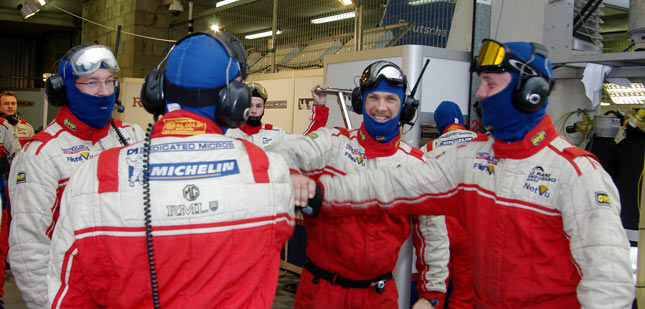
To
put this into perspective, the only driver to press on past
the pitlane on slicks and set a time at the very start of
the opening session was Simon Pullan in the #20 Pilbeam. While
everyone else was heading back into the pitlane to make their
installation checks, he set a best of 4:25.398. It would be
enough to reserve the top slot on the timing screens for the
best part of 45 minutes, and five hours later, the Pilbeam
would still stand eighth overall and fastest in LMP2. By then
outright quickest would have been set by Emanuel Collard in
the #16 Pescarolo on 4:13.832, but that wouldn’t even
be enough to claim pole in GT2 had the conditions been dry.
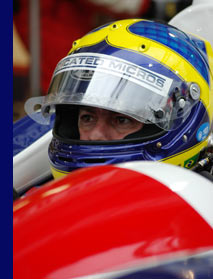 In
that context, and with better weather being predicted for
Thursday, RML’s Phil Barker elected to bide his time
and do the bare minimum necessary rather than risk the car
or his drivers. That strategy began with Thomas Erdos being
sent out soon after the pitlane opened to complete an initial
installation lap, returning straight away to the garage for
the team to carry out the routine precautionary checks. With
a lot of new components on the car since last weekend’s
test there was a warm crackle to the MG as it was pulled back
into the garage, but a swift check-round revealed that everything
was in order. Outside, however, the light misting of drizzle
had turned heavier, and before Tommy was able to set back
out again, a pair of medium-downforce dive planes were fitted
to either side of the MG’s nose section. That took a
few minutes to complete, so it was almost twenty-past before
the Brazilian was on his way again. In
that context, and with better weather being predicted for
Thursday, RML’s Phil Barker elected to bide his time
and do the bare minimum necessary rather than risk the car
or his drivers. That strategy began with Thomas Erdos being
sent out soon after the pitlane opened to complete an initial
installation lap, returning straight away to the garage for
the team to carry out the routine precautionary checks. With
a lot of new components on the car since last weekend’s
test there was a warm crackle to the MG as it was pulled back
into the garage, but a swift check-round revealed that everything
was in order. Outside, however, the light misting of drizzle
had turned heavier, and before Tommy was able to set back
out again, a pair of medium-downforce dive planes were fitted
to either side of the MG’s nose section. That took a
few minutes to complete, so it was almost twenty-past before
the Brazilian was on his way again.
With rain falling heavily
Tommy’s first full flyer came through as a 4:37.683,
and was quick enough for sixth overall, second fastest in
LMP2 behind Pullan’s somewhat unrepresentative –
or merely fortunate – four twenty-five. His second eased
that down to 4:35.048 and would leave the MG fifth after half
an hour. Those top five made strange bedfellows, with the
Pilbeam heading one of the Pescarolos, a GT1 Aston Martin
third, a Ferrari 550 fourth and then Erdos fifth.
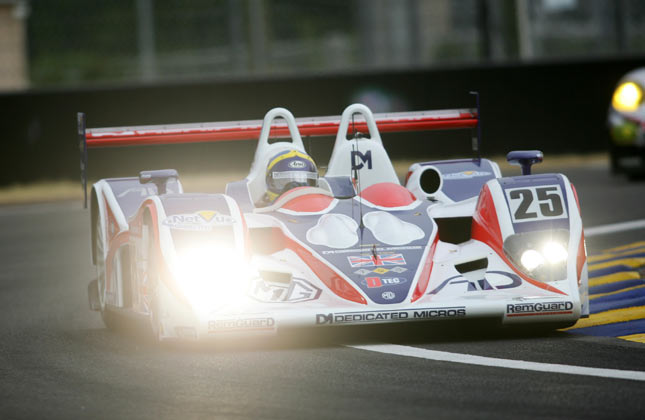
On
his next lap Tommy was given the pitboard signal to return
to the pitlane, where Andy Wallace was waiting for him. While
the drivers swapped places in the cockpit a few adjustments
were made under the engine cover, and then Andy was heading
out smoothly into the gathering gloom. Elsewhere, some drivers
were finding a few extra tenths despite the worsening conditions,
with Lammers up to 4th in the Dome, and Jamie Campbell-Walter
fastest overall in the Creation. With that the Pilbeam had
finally been knocked off its perch and was now second, but
still thanks to Pullan’s first and only flying lap.
“It’s not nice out there, not at all,” said
Erdos. “It’s especially horrid for Andy heading
out there for his first time in a new car. One thing is certain,
though; there’s no point in pushing.”
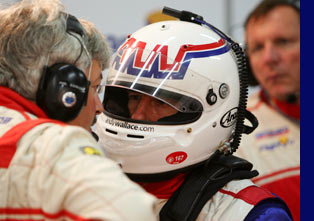 Eight
o’clock came with Andy posting 4:43.163 on his first
flyer, and then following that with a 4:39.974 next time through.
With that first hour completed, a very unusual top ten was
revealed, with the two Pescarolos first and second, the Creation
third, Pullan’s Pilbeam gamely holding on to fourth,
Lammer’s Dome, two Astons and a Ferrari 550. While RML
had been working on their downforce settings, the Intersport
Lola had gone through to claim second spot in LMP2, with the
Lister left to stand tenth and the MG eleventh. Eight
o’clock came with Andy posting 4:43.163 on his first
flyer, and then following that with a 4:39.974 next time through.
With that first hour completed, a very unusual top ten was
revealed, with the two Pescarolos first and second, the Creation
third, Pullan’s Pilbeam gamely holding on to fourth,
Lammer’s Dome, two Astons and a Ferrari 550. While RML
had been working on their downforce settings, the Intersport
Lola had gone through to claim second spot in LMP2, with the
Lister left to stand tenth and the MG eleventh.
Conditions
were not getting any better, and just before ten-past Andy
came burbling back down the pitlane, two laps short of his
original schedule. “It’s just so slippery!”
said Wallace, streams of water dripping from his race suit.
“There are several large puddles, particularly on the
run through to Tetre Rouge and down the far end of the Mulsanne,
and that’s making it a bit difficult, but the car itself
feels great.” Those difficult conditions had persuaded
Phil Barker to instruct his squad to replace the car’s
aerodynamic package with a higher-downforce variant. The front
section was having the double dive-plane sections fitted (see
below), and further adjustments were being made to the engine
mapping to make the traction more manageable out of the corners.
“The car won’t be going out again for a while”
confirmed Phil Barker. “We’re making some changes
to make the car a bit easier for the guys to drive –
something to give them a bit more confidence in these conditions.
It’s like skidding around on an ice pan at the moment!
We’ll increase the downforce levels and then give it
another look. The engine guys have also been trying some new
maps, so we’re working through those as well. Ultimately,
we’re just trying to tune in the car for these wet conditions,
and anything we can learn tonight could prove very valuable
come Saturday or Sunday, if the weather turns wet for the
weekend.”
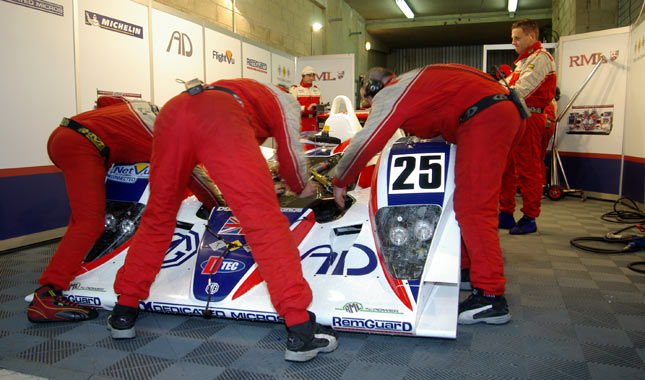
The
team has been working extensively over recent weeks on perfecting
a low-drag package that will allow the MG to make the most
of the long straights here at Le Mans, but they have also
done this in such a way that the car can be swapped back to
the more usual high-downforce settings quickly and easily.
“It may take some time to complete these changes,”
explained Barker, “but we’re prepared for this,
and it’s more important that we know we can make these
adjustments under changing conditions. It’s better to
lose a bit of time making the car safer and easier to drive
than lose the car!”
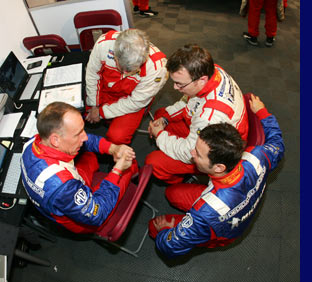 While
other cars were spinning off around the circuit, including
one of the leading Pescarolos, RML neared completion of the
aerodynamic changes. At just after half-eight the new nose
section was fitted, and at 8:38 Andy Wallace headed back out
into the rain. While
other cars were spinning off around the circuit, including
one of the leading Pescarolos, RML neared completion of the
aerodynamic changes. At just after half-eight the new nose
section was fitted, and at 8:38 Andy Wallace headed back out
into the rain.
He
was not gone long. A single tour of the circuit was enough
to convince him that there was nothing to be gained by taking
further risks. “The car’s just perfect,”
he insisted, “but there’s just so much water all
around the track that there’s no point in pressing on.
If you could actually learn something from being out there,
all well and good, but this simply isn’t worth the risk.”
As for the downforce changes – he never got going fast
enough to find out if they’d really made a difference.
“People are spinning off all over the place!”
said Wallace, and to prove his point, the #39 Lola did exactly
that a few moments later, clipping the Armco through the Esses
on Amaral’s second flying lap. It was a glancing blow,
but enough to bring out the red flags and end the session
ten minutes early.
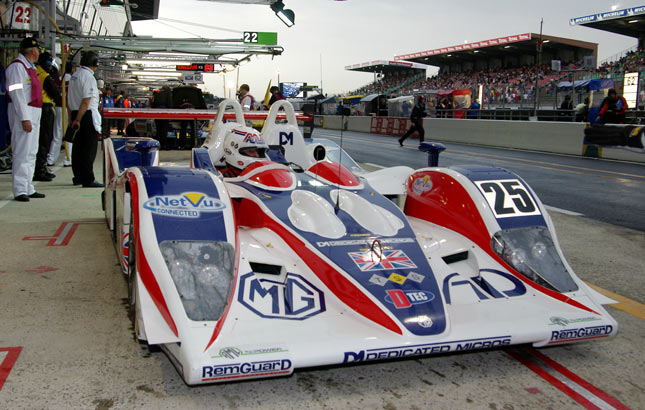
The decision to come in
had been Andy’s, and Phil Barker was full of praise
for his “new” recruit. “I’d much rather
Andy brought the car in that take any risks. It was exactly
the right thing to do. As for what happens later, well, if
it’s as bad as this after the break, we won’t
be going out at all. If it improves, we’ll simply do
the bare minimum.” In the end the rain did ease, during
the break between sessions, only to began again in earnest
as soon as the cars headed out on track. To the accompaniment
of thunder, lightning and enormous dollops of rain, Tommy,
Mike and then Andy completed their minimum requirement of
at least three laps each under cover of darkness. To be more
accurate, Andy did five, and his second flyer clocked 4:34.940
to become the team’s fastest of the evening. “The
conditions are simply horrible. There aren’t even any
tracks to follow. The biggest problem is trying to leave the
corners. There’s a spike in the power as you accelerate
away that makes it difficult to control. If the conditions
for the race look as though they’re going to be anything
like this, then we may have to work on the engine mapping.
In the dry, even when you’re starting out in first gear,
you’re OK. You get used to the way an engine behaves,
and even in low gear, you can open the throttle and know what’s
going to happen next. In these conditions, you simply can’t
do that. If it was going to be like this in the race, then
there might be some point in making changes, but we really
don’t think it will be.”
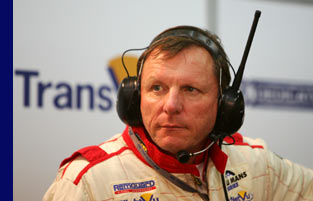 There
was no sense of disappointment in the evening’s proceedings.
Far from it. “That’s our night qualifying done
- mission accomplished, as far as we’re concerned,”
said a contented Ray Mallock, happy to see all three drivers
successfully qualified, and the car still in one piece. Mike
Newton was also pleased to have tested two new fittings on
the car; the new TransVu video system that “worked perfectly”
in the wet, and the equally new supplementary headlight pod,
which fits over the centre of the nose section and gives substantial
additional light. There
was no sense of disappointment in the evening’s proceedings.
Far from it. “That’s our night qualifying done
- mission accomplished, as far as we’re concerned,”
said a contented Ray Mallock, happy to see all three drivers
successfully qualified, and the car still in one piece. Mike
Newton was also pleased to have tested two new fittings on
the car; the new TransVu video system that “worked perfectly”
in the wet, and the equally new supplementary headlight pod,
which fits over the centre of the nose section and gives substantial
additional light.
Having
called it a day half an hour before the flag fell, RML’s
team was able to pack up early and head for their hotel a
little sooner than expected. With fairer weather forecast
for Thursday, much of Wednesday’s running could be rendered
meaningless. “We have a new AER engine lined up for
the race,” concluded Phil Barker. “This is also
a new engine we’re using for qualifying, so we can do
as much running on this one as we want. That means we can
have another go tomorrow, wet or dry, and maybe give the drivers
a chance to see what they can do.”
|
